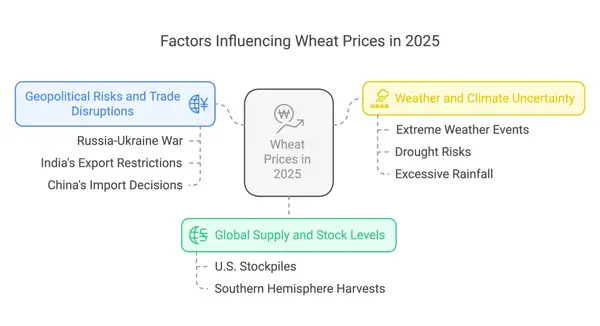2025 Wheat Price Forecast: Updated Expert Predictions

Wheat is one of the world’s most essential commodities. It feeds billions, shapes economies, and plays a central role in international trade. As a key agricultural product, wheat prices influence everything from food costs to inflation rates. Farmers, policymakers, and investors all track wheat markets closely, knowing that even small shifts in supply and demand can have widespread economic consequences.
In 2025, wheat remains in the spotlight as global supply tightens and economic uncertainty looms. As of late February, wheat prices are hovering around $5.52 per bushel, showing slight gains since the start of the year. However, projections suggest a gradual decline to $5.38 by the end of Q1 and potentially $5.03 within the next 12 months. The market is at a crossroads, with multiple forces pulling in different directions.
On one side, falling U.S. wheat stockpiles and climate risks in key growing regions point to possible supply shortages. On the other, strong production from Australia and Argentina and China scaling back its wheat imports are keeping prices from surging. Geopolitical risks, trade disruptions, and shifting demand patterns are also influencing the market, making 2025 a year of uncertainty.
Will wheat prices rebound, or are we heading toward a continued downturn? Understanding the key drivers of the market is essential for traders looking to make informed decisions.
What’s Driving Wheat Prices in 2025?
The wheat market is shaped by supply and demand imbalances, climate conditions, trade policies, and global economic trends. While stockpiles have shrunk, new supply is entering the market, and demand patterns are shifting.

Global Supply and Stock Levels
U.S. wheat stockpiles have dropped from 1.98 billion bushels in Q3 2024 to 1.57 billion bushels in Q4, raising concerns about future availability. Historically, lower stock levels lead to higher prices, but so far, strong harvests in the Southern Hemisphere have balanced the equation. The FAO Cereal Price Index has edged slightly higher, but no major rally has materialized yet.
Geopolitical Risks and Trade Disruptions
Wheat prices are sensitive to global trade policies and conflicts. The Russia-Ukraine war continues to cast uncertainty on Black Sea wheat exports, a critical supply route for Europe and the Middle East. Meanwhile, India has restricted wheat exports to maintain domestic food security, tightening global availability. China’s decision to delay or redirect 600,000 tons of wheat imports has also reduced demand pressure.
So far, global wheat trade remains functional, but any escalation in geopolitical tensions or new export restrictions could change that quickly.
Weather and Climate Uncertainty
Extreme weather events are another major factor influencing wheat prices. Warmer-than-expected temperatures in India have raised concerns about lower wheat yields. In the U.S. and Canada, drought risks remain, while excessive rainfall in Europe and Australia has improved yields but could create logistical challenges. If adverse weather affects key growing regions, wheat prices could spike suddenly.
Wheat’s 2024 Performance and Possible Scenarios for 2025
Last year was a rollercoaster for wheat. Prices fluctuated between $5.50 and $7.00 per bushel, surging at times due to supply concerns, then cooling as global harvests stabilized. The U.S. stockpile decline was significant, but stronger-than-expected yields in parts of Australia and Argentina prevented a full-blown supply crisis.
Where Could Wheat Prices Go in 2025?
The wheat market is currently moving between supply constraints and strong production from alternative sources. Three key scenarios could play out:
- A price rebound ($6.50+ per bushel): If stockpiles keep shrinking and geopolitical tensions disrupt trade, wheat could break past $6.50 per bushel as demand outstrips supply.
- A stable market ($5.00–$5.50 per bushel): If supply and demand remain balanced, wheat may continue trading in its current range.
- Further declines ($4.50 per bushel or lower): If harvests remain strong, energy costs decline, and demand weakens, wheat prices could dip below $5.00 by the end of 2025.
A lot depends on how weather patterns unfold and whether major exporters impose new restrictions.
Expert Wheat Price Predictions for 2025
Wheat prices are holding steady around $5.52 per bushel as February comes to a close, but analysts remain divided on where the market is headed next. While some forecasts suggest prices could climb due to tightening global supply, others predict a modest decline as new harvests come in.
The USDA maintains its wheat price forecast at $5.55 per bushel for the 2024/25 marketing year, suggesting a relatively stable outlook based on current supply and demand trends. Meanwhile, the agency expects a 2% increase in winter wheat planting for 2025, which could influence future supply levels and price movements.
ING Group takes a more bullish stance, predicting wheat prices will average $6.00 per bushel throughout 2025. Their forecast is based on expectations that global wheat stocks will decline to their lowest levels in over a decade, adding upward pressure on prices.
The World Bank, on the other hand, expects wheat prices to ease slightly, forecasting a 2% decline to $265 per metric ton (around $7.22 per bushel) due to increasing global grain production. If supply remains strong, this could limit price spikes and keep the market well-balanced.
Other projections fall somewhere in between. Farm Progress forecasts an average wheat price of $5.26 per bushel for the 2025 harvest, with potential swings between $4.33 and $6.83, depending on how global conditions unfold.
Overall, predictions for wheat prices in 2025 range between $5.26 and $6.00 per bushel, with key factors like crop yields, export policies, and geopolitical risks playing a crucial role in determining the final outcome. If supply remains steady, prices could drift lower, but if weather disruptions or trade restrictions emerge, wheat could see a stronger rally.
With wheat prices expected to remain volatile, traders need a clear strategy to navigate market swings. Supply uncertainties, trade policies, and unpredictable weather make wheat a highly active commodity—offering both buying and short-selling opportunities. Instead of simply holding wheat for the long term, traders can capitalize on price movements in both directions.
Monitor Key Market Trends
Wheat prices can shift suddenly based on new developments. Keeping an eye on:
- Global stock reports and production forecasts to track supply trends.
- Trade policy changes and geopolitical risks that could disrupt exports.
- Weather conditions in key wheat-growing regions, which often dictate harvest success.
- Following these indicators closely can provide early signals for potential price swings.
Manage Risk With a Clear Strategy
In a market that moves quickly, risk management is essential. A structured plan includes:
- Stop-loss orders to protect against unexpected price reversals.
- Take-profit levels to lock in gains before momentum shifts.
- A disciplined trading approach to avoid emotional decisions during price fluctuations.
- Wheat’s price swings create trading opportunities, but success depends on having a solid strategy. With the ability to go long or short on Morpher with zero commission, traders can adapt to market conditions and make the most of wheat’s volatility.
Go Long or Short on Wheat With Zero Commission
Instead of waiting for a long-term price trend, traders can actively trade wheat’s volatility. When prices rise, traders can go long to profit from an uptrend. If prices decline, traders can go short and benefit from falling markets.
Morpher’s zero-commission trading platform makes this strategy even more effective. Whether betting on a wheat price rally or a pullback, traders can execute trades instantly—without paying unnecessary fees.

Looking for a Fun Alternative? Track the Pizza Index!
Wheat prices don’t just impact global trade, they also affect something much closer to home: the price of pizza. That’s why Morpher’s Pizza Index tracks the cost of making a pizza based on wheat, cheese, and other essential ingredients. It’s a lighthearted but insightful way to see how commodities influence everyday life.
If wheat prices rise, expect your pizza slice to cost more. If wheat declines, maybe your favorite pizza deal gets a little cheaper. Either way, whether you’re tracking serious market trends or just wondering if your next pizza night is getting pricier, Morpher offers a unique way to engage with commodity trading.

FAQ: Wheat Prices and Market Trends
Why are wheat prices so low?
Wheat prices have been declining due to increased global supply, weaker demand, and improved trade flows. Large harvests from major producers like Australia, Argentina, and Russia have added to global stockpiles, preventing price spikes. Additionally, China’s reduced wheat imports have softened demand, keeping prices lower.
Why are wheat prices going down?
Several factors are pushing wheat prices lower, including:
- Strong production in key wheat-growing regions, increasing global availability.
- Declining export restrictions, allowing more supply to reach international markets.
- Falling input costs, such as fertilizer and transportation, reducing production expenses.
How low can wheat prices go?
While no one can predict the exact floor price, most analysts suggest wheat prices could drop to around $5.00 per bushel or slightly lower if supply remains strong and demand continues to weaken. However, unexpected events like droughts, geopolitical tensions, or new export bans could prevent a further decline.
How high will wheat prices go?
If market conditions shift such as poor harvests, trade restrictions, or a spike in demand—wheat prices could rise above $6.50 per bushel. Some analysts, like ING Group, believe that tightening global wheat stocks could push prices higher, particularly if weather conditions worsen.
What are wheat prices going to do?
Most forecasts suggest that wheat prices will remain stable or slightly lower throughout 2025. However, the market remains unpredictable, and factors like global weather events, export bans, or increased demand from major buyers like China and India could change the trend.
Why are wheat prices going up?
Wheat prices can rise due to poor crop yields, geopolitical conflicts, and trade restrictions. In the past, supply disruptions in Ukraine and Russia caused sudden price spikes. If similar disruptions occur, or if weather damages crops, prices could rise again.
How to read wheat futures prices?
Wheat futures prices reflect the expected cost of wheat for delivery at a future date. These prices depend on:
- Current supply and demand conditions
- Weather patterns affecting crop yields
- Economic policies and trade regulations
For traders, understanding wheat futures helps predict price movements and manage risk in the commodities market.
When will wheat prices go up?
Prices could rise if global stockpiles decrease, climate conditions reduce supply, or demand from major wheat-consuming nations increases. If any of these occur, wheat could rebound from its current levels.
Wheat prices in 2025 are balancing between strong global supply and potential market disruptions. While most forecasts suggest stability or a slight decline, unexpected factors like weather shocks or trade restrictions could shift the market quickly.
For traders, this volatility presents opportunities. Whether going long on a price recovery or shorting further declines, Morpher’s zero-commission trading platform allows you to act on market movements efficiently.
Trade wheat today on Morpher and take advantage of price swings in the global commodities market.

Disclaimer: All investments involve risk, and the past performance of a security, industry, sector, market, financial product, trading strategy, or individual’s trading does not guarantee future results or returns. Investors are fully responsible for any investment decisions they make. Such decisions should be based solely on an evaluation of their financial circumstances, investment objectives, risk tolerance, and liquidity needs. This post does not constitute investment advice.

Painless trading for everyone
Hundreds of markets all in one place - Apple, Bitcoin, Gold, Watches, NFTs, Sneakers and so much more.

Painless trading for everyone
Hundreds of markets all in one place - Apple, Bitcoin, Gold, Watches, NFTs, Sneakers and so much more.









